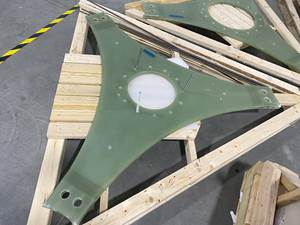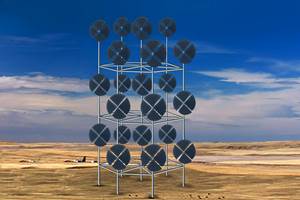U.S. administration sets stage for offshore floating wind turbines
Pacific Coast opened to advance areas for offshore wind off the northern and central coasts of California, follows the call for 30 GW offshore wind deployment by 2030.

Photo Credit: Joshua Bauer/National Renewable Energy Laboratory (NREL)
On May 25, the White House convened National Climate Advisor Gina McCarthy, California Governor Gavin Newsom, Interior Secretary Deb Haaland and Under Secretary for Defense for Policy Dr. Colin Kahl to announce an effort to advance areas for offshore wind off the northern and central coasts of California, opening up the Pacific Coast to what is said to be its first commercial scale offshore clean energy projects. This milestone is part of the current administration’s goal to create thousands of jobs through the deployment of 30 gigawatts (GW) of offshore wind by 2030 (see “White House to jumpstart offshore wind energy projects”). These initial areas for offshore wind development in the Pacific Ocean could potentially bring up to 4.6 GW of clean energy to the grid, enough to power 1.6 million American homes.
More specifically, the Department of the Interior, in coordination with the Department of Defense (DOD), has identified an area (the Morro Bay 399 Area) that will support three GW of offshore wind on roughly 399 square miles off California’s central coast region, northwest of Morro Bay. The Department of the Interior says it is also advancing the Humboldt Call Area as a potential wind energy area, located off northern California. These identified areas will enable the build out of a significant new domestic clean energy resource.
Because the DOD engages in significant testing, training and operations off the coast of California that are essential to national security, the department is said to play a critical role in identifying these new areas for offshore wind development. The Department of the Interior acknowledges the critical nature of current and future military testing, training and operations and that the operational integrity thereof is a national security imperative. It will work closely with the DOD to ensure long-term protection of military testing, training and operations while pursuing new domestic clean energy resources.
Further, because the outer continental shelf falls away much more quickly into much deeper waters in the Pacific than it does in the Atlantic Ocean, new floating offshore wind technology will be deployed in offshore California waters. Notably, and as a further demonstration of the Biden administration’s whole-of-government approach to clean energy development, the. Department of Energy (DOE), through its Office of Energy Efficiency and Renewable Energy and ARPA-E (Advanced Research Projects Agency–Energy) has invested more than $100 million in researching, developing and demonstrating floating offshore wind technology (see “ATLANTIS program develops 12-MW floating offshore wind turbine concept”). These investments are said to have helped position the U.S. as a leader in the emerging global floating offshore wind market.
These announcements follow the Administrations approval of the Vineyard Wind offshore wind project in Massachusetts, advancing its construction and operation.
“Tacking the climate crisis is a national security imperative and the Defense Department is proud to have played a role in this important effort,” notes Under Secretary for Defense Policy Dr. Colin Kahl. “The Defense Department is committed to working across the U.S. government to find solutions that support renewable energy in a manner compatible with essential military operations. Throughout this effort, the Defense Department has worked tirelessly with the White House, the Department of the Interior and the State of California to find solutions that enable offshore wind development while ensuring long-term protection for testing, training and operations critical to our military readiness. The Defense Department applauds this step and looks forward to continued coordination to address the climate crisis.”
Related Content
RTM, dry braided fabric enable faster, cost-effective manufacture for hydrokinetic turbine components
Switching from prepreg to RTM led to significant time and cost savings for the manufacture of fiberglass struts and complex carbon fiber composite foils that power ORPC’s RivGen systems.
Read MoreCollins Aerospace to lead COCOLIH2T project
Project for thermoplastic composite liquid hydrogen tanks aims for two demonstrators and TRL 4 by 2025.
Read MoreDrag-based wind turbine design for higher energy capture
Claiming significantly higher power generation capacity than traditional blades, Xenecore aims to scale up its current monocoque, fan-shaped wind blades, made via compression molded carbon fiber/epoxy with I-beam ribs and microsphere structural foam.
Read MoreComposites end markets: Batteries and fuel cells (2024)
As the number of battery and fuel cell electric vehicles (EVs) grows, so do the opportunities for composites in battery enclosures and components for fuel cells.
Read MoreRead Next
Developing bonded composite repair for ships, offshore units
Bureau Veritas and industry partners issue guidelines and pave the way for certification via StrengthBond Offshore project.
Read MorePlant tour: Daher Shap’in TechCenter and composites production plant, Saint-Aignan-de-Grandlieu, France
Co-located R&D and production advance OOA thermosets, thermoplastics, welding, recycling and digital technologies for faster processing and certification of lighter, more sustainable composites.
Read More“Structured air” TPS safeguards composite structures
Powered by an 85% air/15% pure polyimide aerogel, Blueshift’s novel material system protects structures during transient thermal events from -200°C to beyond 2400°C for rockets, battery boxes and more.
Read More
























